This is an article by M.M. Meleen originally published in Tarosophy Magazine in 2016 Vol II Issue 7. I was hunting around the blog and saw my original post about it realized I’d never published the article here. At the time, I was supposed to get a Lulu link where I, or anyone else, could purchase a hard copy of that issue of the magazine, and I would have passed that on to you as promised. But I never got it. So since I stumbled onto a mention of this in 2016 (on the “Ides of March”, exactly 5 years to the day after that original post directing people to the magazine), I decided why not publish it here, finally, for all.
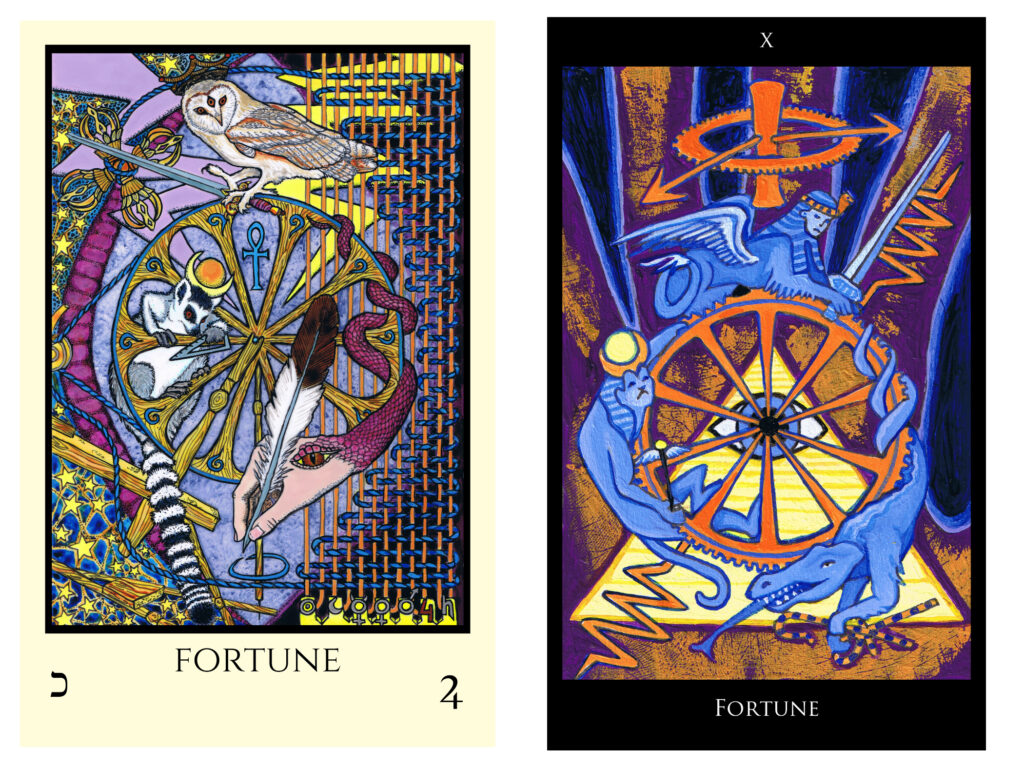
Tarot Zoology: A Field Guide to the Tabula Mundi by M.M. Meleen
Methods of portraying archetypal and allegorical symbolism abound, and are as diverse as tarot decks themselves. Yet animal figuration seems to be a constant, and one would be hard pressed to find a single deck with no animal symbolism of any kind. Even in a deck that would not be considered animal based or themed, there are many ways in which animals can have a presence. This can be as prevalent as the Knights generally shown seated on horseback denoting swiftness and force, or as subtle as a decorative element on a garment or an object. Purposely focusing attention on the symbolism of the animals present in a reading can add an additional layer of meaning. This is often done on a subconscious level, as humans have lived with the animal kingdom from the dawn of humanity.
Mankind is familiar with animal symbolism in folklore, mythology, alchemy, astrology, and fairy tales. When animals appear, we often have no trouble forming an instant impression of what they bring to mind. Sometimes the depictions of animals may be so subtle that one is not aware of how they may be influencing perception. Much like the sense of smell, an animalian gift, these images trigger memories and evoke the primal unconscious. Bringing some conscious consideration to this can be illuminating. Asking oneself why certain animals find their natural habitat in certain cards can be fruitful, whether it is a study of a particular deck, or noticing how animal symbolism repeats itself in the same card over myriad decks. Become a Tarot Zoologist. Seek out and learn to identify animals “in the field” of Tarot.
This guide is only a brief synopsis of what is possible. It is illustrated with examples from the tarot deck called Tabula Mundi, as a deck called “picture of the world” must of course include some of the world’s creatures. This deck serves as one example of the many ways that animals are used symbolically in tarot, for it is not an animal deck per se, but is coded with animal images used as an occult or hidden script. These serve as an archetypal cosmology or form of language. In fact, going through the seventy-nine images of the deck (seventy-eight cards and the card backs) only eight cards contained absolutely no hint of zoological emblem.
Examining the way animal symbolism is used in different decks is one way to analyze a deck’s personality. How many types of animals appear in a deck, what are they, and how many of each do you find? Let us delve into some illustrated examples of tarot creatures in their natural habitat. When surveying the wildlife population in a deck consider your first count as potentially being understated, as it is very easy to miss some of them in the wild. Challenge yourself to find every animal in your favorite deck. You may discover that it takes careful observation to locate them all. First though, one must define the ways in which animals can show up in a deck.
- Animals as seen in nature, showing up on a card as themselves, performing some action or being present as part of the scene
- Animals as portrayed in heraldry, often seen as a blazon on a coat of arms, flag or shield in positions with specific meanings
- Animals symbolically present as part of an object, such as a decorative element on a suit element or part of an article of clothing
- Animals as human companions or familiars
- General human-animal hybrids wherein a human figure combines with an animal component such as the lower body of an animal, or the horns, wings or head of an animal and general compound animal hybrids that combine multiple animals
- Mythological creatures with specific names and histories
- Animal-related objects or parts, embryonic or skeletal stages of animals, or animals suggested but not physically present such as depiction of honeycomb, eggs, furs, bones, chrysalises, shells, feathers or wings, which may suggest animals, birds, mollusks, bees or other insects
- Animals as court crest elements and in court card traditional depictions
Following are just a few pictures illustrating each example – there are lots more to find in the cards! (The first 7 are from the color version of Tabula Mundi and the last from the black and white edition.) After that, we get to the good stuff – the symbolic meanings!
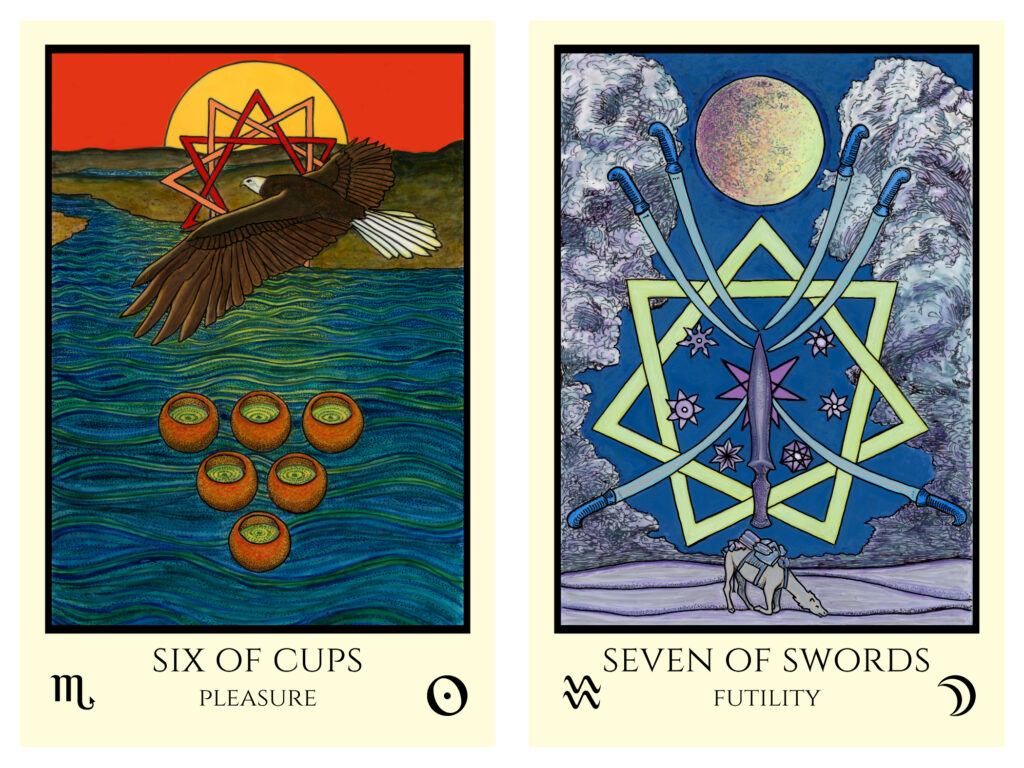
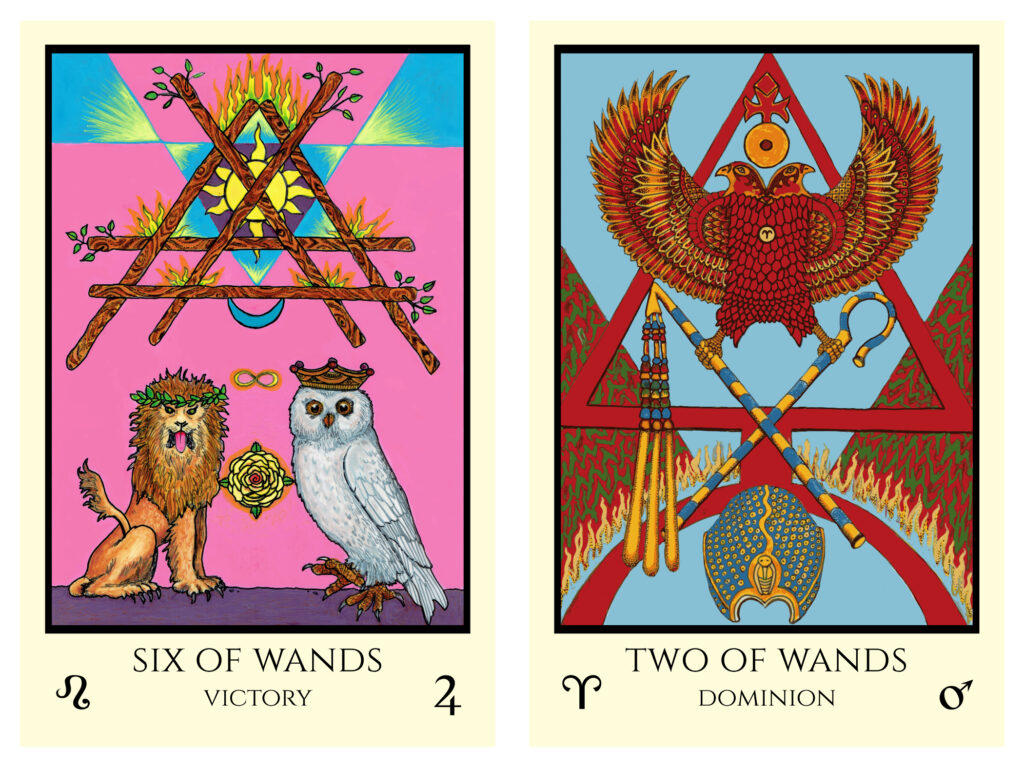
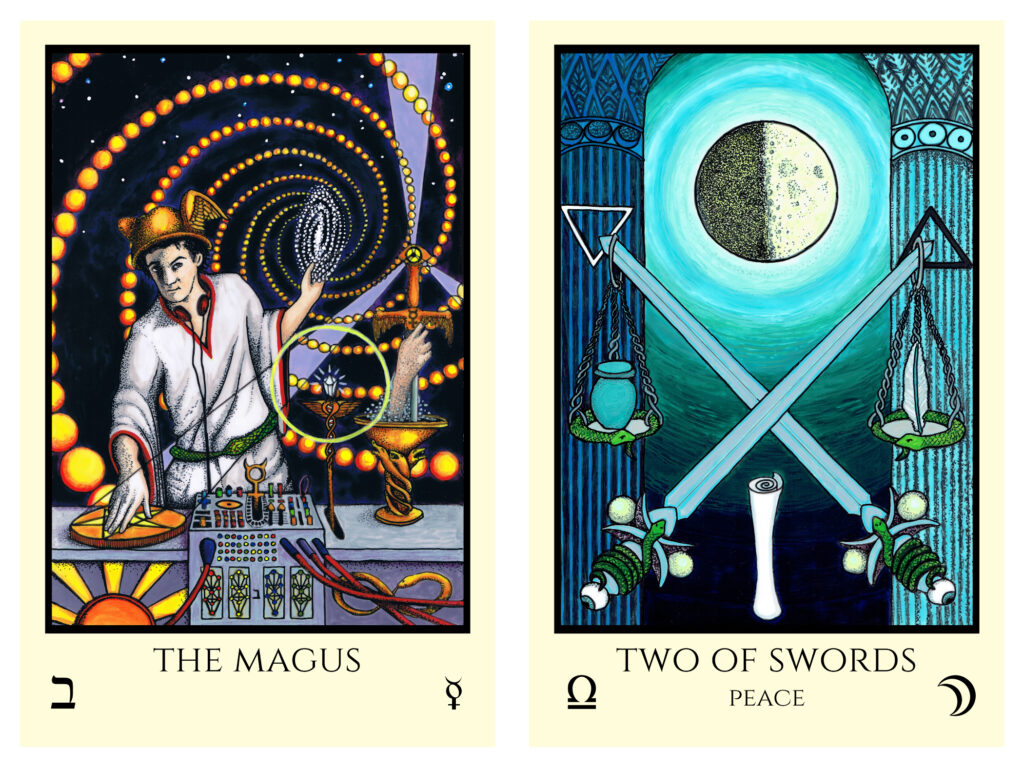
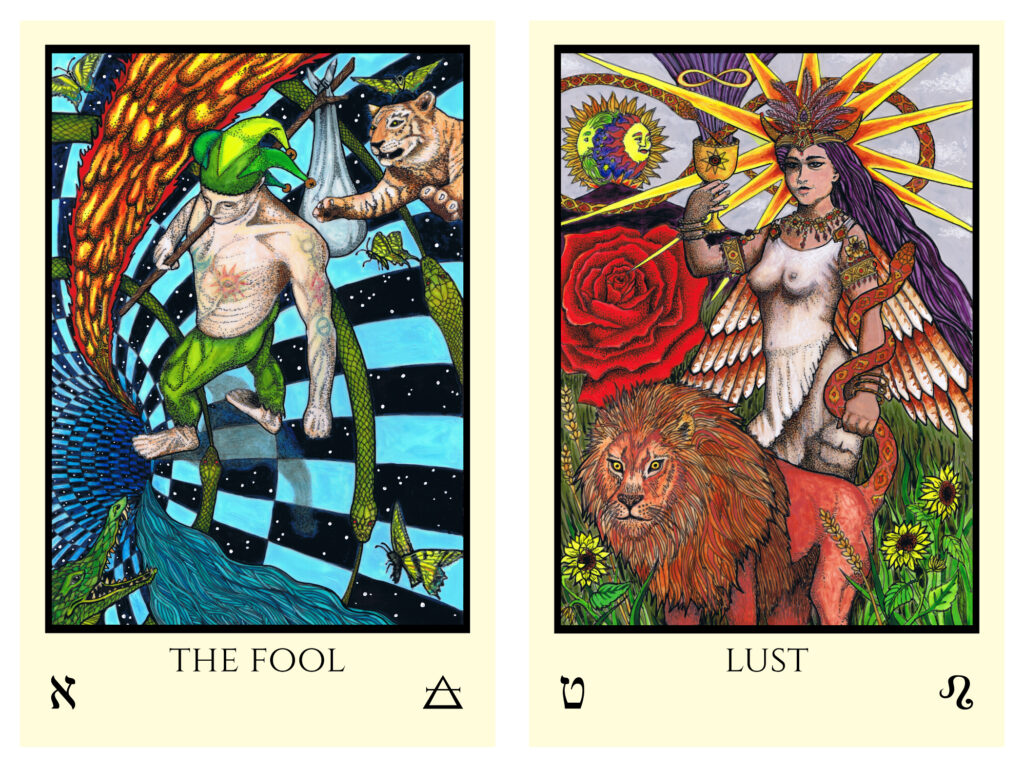
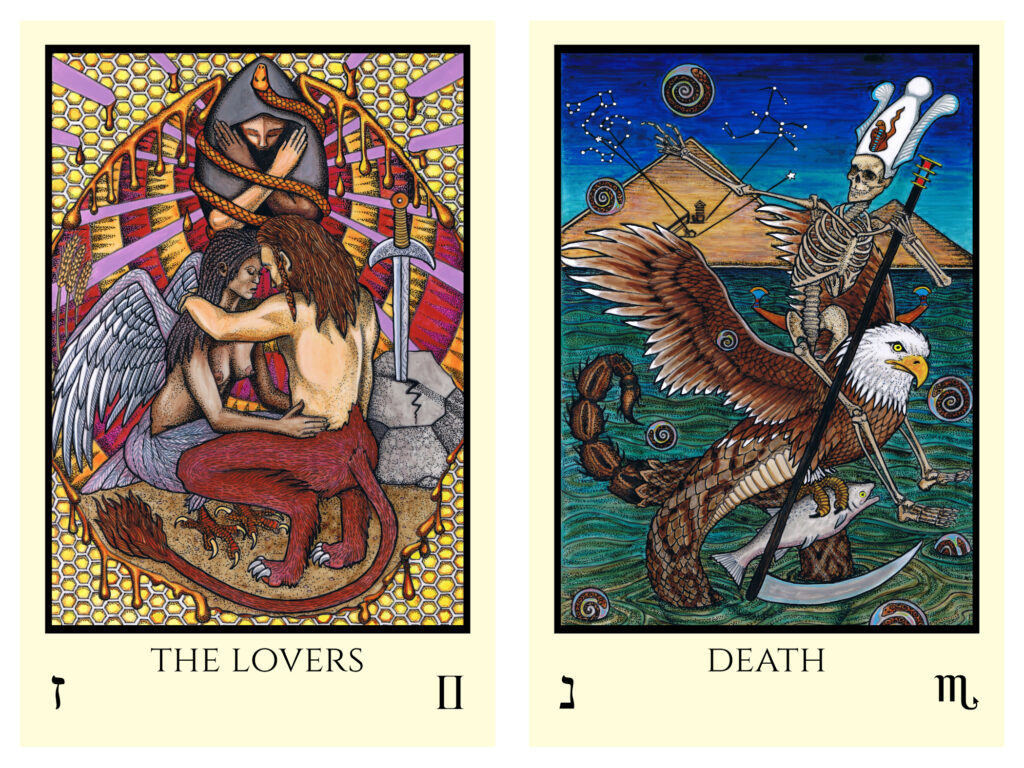
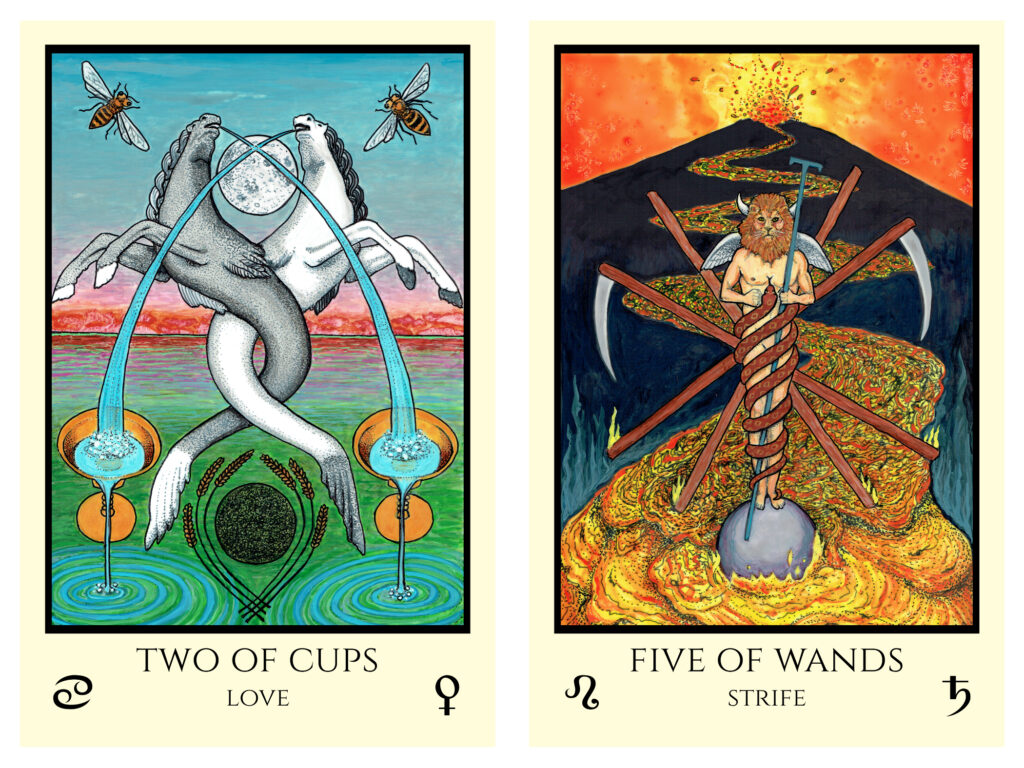
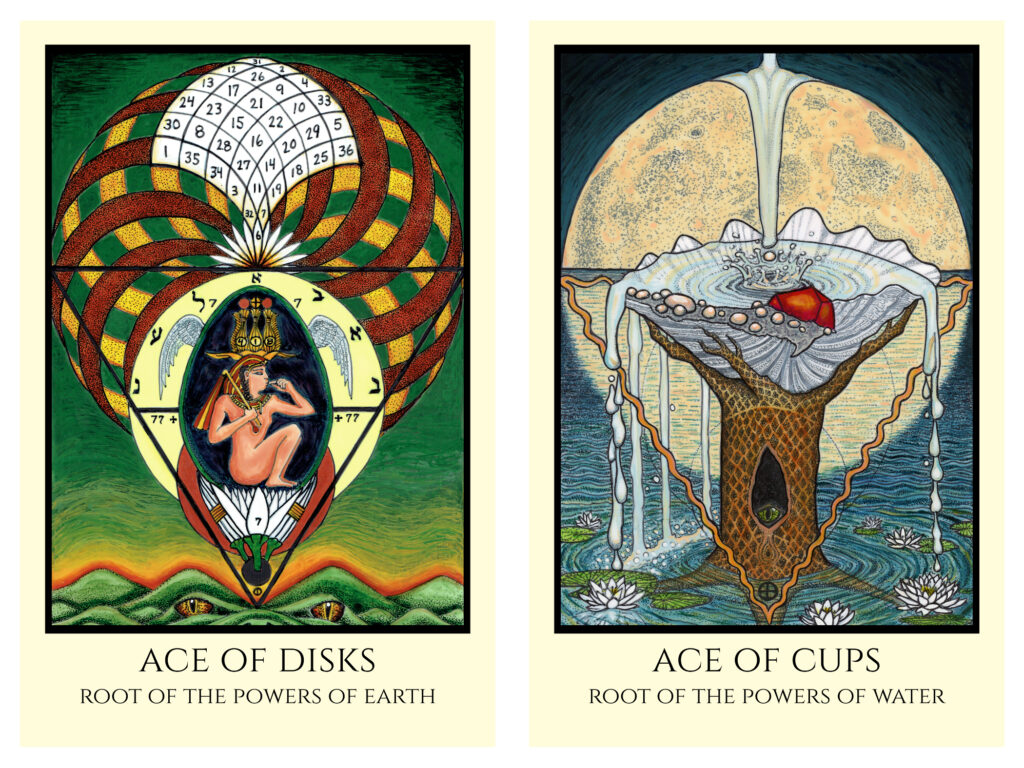
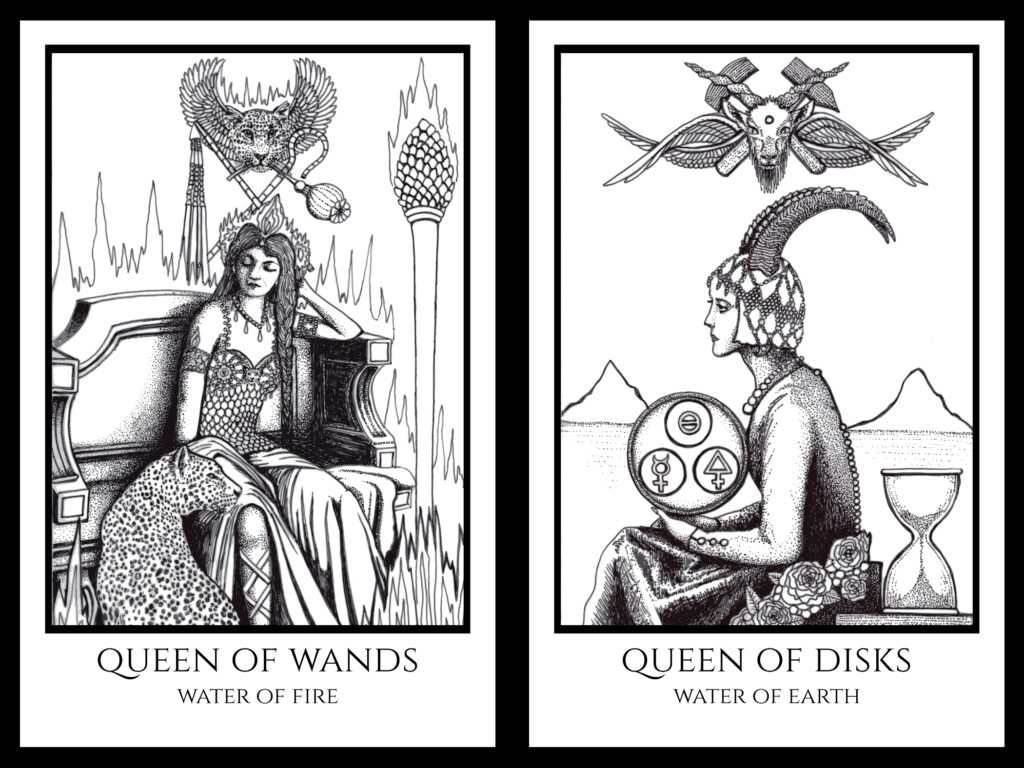
In the Tabula Mundi, seventy cards, and the card backs, portray some animal symbolism. Many types of natural animal, plus some objects and hybrids suggesting them, and several specifically named mythological creatures, can be seen in the cards. The most common animal was the Snake or Serpent which appeared on forty percent of the cards. Many snakes were only present in subtle ways, such as a decorative element on an object, or part of a hybrid animal. The preponderance of Serpent imagery is an indication that this deck is a potent tool of transformation and knowledge, some primary messages of Snake.
Mythological creatures with distinct names known in folklore were counted separately, and were the second most commonly occurring element. More general human-animal hybrids were third most common, as they include the winged or horned archetypal humans present in many of the Majors and Courts. The prevalence of mythological creatures and hybrids gives the deck an aura of mystery and magick and brings in legends and fables from the collective consciousness. Mythological creatures have their own stories that can provide layers of meaning and trails to follow. For other unnamed hybrids, one can simply study their component animals.
Back in the natural world, the second most common real animal in the Tabula Mundi is the Eagle, virtually tied with the Lion. Given the fact that they are both kerubic beasts, and a very symbolic pair alchemically, it isn’t surprising. They show up singularly and also together on several cards. These two are rulers. The Lion is the majestic king of the beasts and the Eagle is the far-seeing sovereign of the air, symbolic of mastery of Heaven and Earth, the realms of Tabula Mundi. The Lion is the Kerub of Fire, and is symbolic of great heart, dignity, strength, and honor. The Eagle is most generally the Kerub of Water (though sometimes switched with Air in Crowley’s Nox formula) and stands for perceptive vision and clarity, higher purpose, and nobility of spirit.
The following is a concise description of meanings that may be suggested when each animal appears in the cards, depending on context. When analyzing a reading specifically for animal symbolism as a practice, considering the animals’ habits and folklore can be an interesting exercise.
Zoomancy, or Theriomancy, is a method of divination that derives auspices from the appearance and behavior of beasts. A Zoomantian spread one can do with any deck is to separate out every card with animal symbolism, and from these draw four cards, one for each of the four elements and directions, and read them totemically for any animals that appear in order to receive a unique message from the animal kingdom.
Mundi Creaturae
Natural Animals
- Bat Mysteries of the night. Sonar, echo location, and the ability to navigate darkness. Mesmerism. Madness. Seeing through illusion. Facing fear.
- Bee Venus, Binah, the yoni. Sweetness of life. Diligence and industriousness. Solar and lunar forces. Pollination and fertilization. Wild nature, the swarm and the sting. Royalty.
- Beetle The Scarab and the solar barge, passages of change. The midnight sun. Resurrection and purification.
- Boar Ferocity and confrontation. Fearlessness in the face of danger. War and chaos. The Calydonian hunt. The destructive rampage. Masculine urges. The earthquake.
- Bull Taurus.Kerub of Earth.Fecundity of earth; the sowing.Virility and strength. Productivity. Beast of burden; physical labor and endurance. The Minotaur.
- Butterfly The chrysalis.Transformative journey of the soul. Element of Air. Transmutation. Moment of conception in the womb.
- Camel The letter Gimel.The ship of the desert. Transporting valued cargo; knowledge. Crossing the Abyss. Stamina on an arduous journey. The destination.
- Crab/Crayfish Forces of the Moon. Cancer and Pisces. Armor and defense. Maternal protection. The subconscious. The indirect path.
- Crocodile Primal nature of water. Silence. Initiation. The mysteries of birth and incarnation. Sobek. Guardians of hidden knowledge. Fertility. Clairvoyance. Letter He final. Feminine form of Dragon.
- Dog (See Cerberus)The most loyal companion. Willingness. Protection on the journey and at the home. Master the senses and follow the trail of things not ordinarily seen.
- Dolphin The womb. Protector of the waters. Friendship of deities. Sonar powers, navigation, and memory. Unexpected help.
- Dove Venus,Aphrodite, female sexuality. Creativity. Maternity. Peace and pacifism. Beauty and gentleness. Messages. After the deluge.
- Dragonfly Magic. Air over the waters. Swiftness and lightness. Shifting colors. New perspective. Summer. Visionary brilliance and the fleeting nature of thought.
- Egg Incarnation. Orphic egg that contains the universe. Result of the hermetic marriage. Fertilization. The ideal, and all potential. Incubation. New knowledge. Promise of flight at maturity.
- Eagle/Hawk Clear vision. Exaltation above matter. Higher purpose. Leadership. Divine truth. Spiritual ecstasy and nobility of spirit. In some cards, the white eagle of alchemy; the purified salt.
- Elephant Royal and majestic power. Strength and authority. Earth. Money and material concerns. Memory for injustice. Solidity and endurance.
- Feather Communication with spirit. Writing and treaties. Virtue. Lightness. Maat and weighing the heart. Truth and order. Flight. Rising above.
- Fish The sign of Pisces. Christ. Sacrifice and crucifixion. Prophecy and inspiration. The letter Nun. Beneath the waters. The flow of life. The Salmon of Wisdom. Prosperity, surplus. Initiation and baptism.
- Goat The sign of Capricorn. The Zenith. Climbing and ambition. Baphomet. Pan the Satyr, god of Nature. Libido and craving. Surefootedness. Business opportunity. Power.
- Honeycomb/Beehive (See Bee) Honeycomb as container of the elixir, the hexagon and harmonic structure. Beehive as the sweet reward that comes from perfect structure, organized labor, and well-governed industry. The perfect union of opposites. Harmony. Tiphareth. Solve et coagula, nectars transmuted to honey.
- Horse Swiftness, strength, and vitality. First force and the Will. Exploration and travel; a journey. Freedom of sexuality. The Centaur. Sagittarius.
- Ibis A bird of the waters. Thoth. The lunar forces and cycles of time. The maternal instinct. In alchemy, the successful transmutation.
- Jackal Anubis, protector of the dead, of tombs. Guide of the soul. Guardian of the scales. Wepwawet, the Opener of the Ways, stands at the prow of the solar barge.
- Leopard/Panther Inner power. Ecstatic meditation. Shakti essence. Silence and speed. Controlled transformation. Sexual awakening.
- Lemur Higher knowledge. Hermanubis. Mercurial function. Intelligence. Communication and answers. Messages. Happiness and playful fun. Enjoying life.
- Lion Leo.The Sun.Solar fire kerub. Courage and kingship. Protector of the good. Strength. The red tincture of alchemy. Passion. Gold. Pride. The brave heart and the strong spine.
- Mollusk/Shell The Yoni. The feminine principle.The pearl. Beauty, luxury. Perfection of form. Soothing irritation. Protection of form. The lunar forces and phases. Love. Aphrodite, Venus, Lakshmi, Binah. Emotional high.
- Moth Cycles of soul change. The cocoon. Nocturnal otherworldliness. Influenced by lunar force. Dreams. Illusions. Shadows. Seeking the light even unto destruction.
- Owl The true reality.Vigilance. Cycles of reincarnation. Wisdom and intelligence. Minerva and Athena. High Magick. Lunar power. Omens, prophecy. Psychic awareness. Astral projection.
- Peacock Cauda Pavonis, the alchemical stage of truth or deceit. Transcendence. Integrity and incorruptibility. Beauty and the influence of Venus.
- Ram/Sheep Aries. The start of a cycle. Spiral life force. The head, mental power. Dominion and dueling. Opportunity, strength, and challenge. Renewal of Spring.
- Raven/Crow Magick and the night.Alchemical death. A trickster. Shape-shifting, theft, and deception. High intelligence. The power of language.
- Scorpion Sign of Scorpio. Venom and stinging. The will to change. First stage of putrefaction. Desire nature. Potency. Passion and pathos.
- Snake/Serpent (see Ouroboros)The knowledge of good and evil. The temptation of Eve. Wisdom, initiation. Kundalini. Transformation and healing. Immortality. Sometimes Hadit. Cycles of death and rebirth; cycles of Time.
- Stag Wild nature. Masculinity and virility. The hunt. Renewal of life. The generative force of the land.
- Swan Grace, beauty, and purity. The embodied soul. Love and partnership. Aphrodite. The Muses and inspiration, poetry and music.
- Tiger.Fiery passion and sensuality. Power and sleekness. Solitary magnificence. Durga. Ferocity. Beauty of motion. Willpower and courage.
Mythological Creatures
- Arch Fey (see Butterfly, Dragonfly, Moth) “Arch” meaning cunning, crafty, mischievous, sly and also in combination with other words, meaning chief, leader, ruler. “Fey” meaning fairies, seen usually as slight beings with butterfly, moth, or insect wings.
- Cerberus (See Dog) Hound of Hades. Guardian of the adamantine gates. Psychopomp companion. Three heads for mastery of speech, action and thought.
- Chimera (see Goat, Lion, Serpent) Fire breathing multi-part creature infused with all the strength and agility of its parts. One of many monstrous offspring of Typhon, the last son of Gaia and Tartarus (the Abyss). Omen of disaster.
- Double Headed Eagle (See Eagle) Rulership in all directions. Authority in both secular and religious matters.
- Dragon (See Crocodile, Ouroboros, Serpent) Guardian of wisdom. The treasure of the Great Work and the Philosopher’s Stone. Chi and life force; power. Control of the beast within; the inner quest. Rule of the elements. Balance of male and female. If winged, the volatile; if not, the fixed.
- Griffin (See Eagle, Lion) As combination of the king of beasts and the sovereign of the air, the Griffin is said to be a ruler combining the strength of both. Guardian of that which is precious.
- Hippocampus (see Dolphin, Horse) Horses above and Dolphins below. The Chariot of Poseidon. Mounts of the Nereids. Seahorse shaped parts of the brain; the limbic system. Skills of navigation. Savior of sailors. Loyal, graceful and agile. Good omen.
- Medusa (see Snake)A Gorgon, female with snakes for hair whose gaze turns one to stone. Aegis of Athena. Divine protection. Medusa from Greek meaning guardian, protectress. Gorgon, from the word meaning dreadful. Ward against evil.
- Oneroi (see Bat, Crayfish, and either Serpent or Fish) Black winged demons who live by the Gates of Horn and Ivory. Personification of dreams. Descended from Nyx, the Night, and Hypnos, God of Sleep. The Siren. Two worlds; the Otherworld. Passing through the veils.
- Ouroboros (see Snake) Tail-devouring serpent, symbol of infinity and cycles of time. Regeneration. The Azoth. The alchemical maxim “One is All” and the concept of self-sufficiency.
- Sobek/Sebek (see Crocodile) Egyptian crocodile deity, both Creator and Devourer, name derived from a verb meaning “to impregnate”. The Hé final process in the formula of the Tetragrammaton.
- Sphinx (see Lion, Bull, Eagle as applicable by type) The Mysteries. Sun worship. Enigma; secrets and riddles revealed. Tiamat, slain by Marduk to create Heaven and Earth. Symbol of Malkuth, connection to Kether. Man’s highest potential. The cross within the circle. The soul thru space and time. The rose cross, the expanded Tau cross. The four Kerubs combined. Light, Love, Liberty and Life. The Great Work. The four powers of the Sphinx are To Will, To Dare, To Know, and To Keep Silent and together, they create the fifth power To Go. Also, when as human headed lion, symbolizing a lion’s strength and a ruler’s intelligence.
- Zurvan (see Lion, Bull, Eagle, Snake) Mesopotamian demonic deity of Limitless Time, and Time of Long Dominion. Maturity, growth, and decay. Associated with the Axis Mundi, or center of the world.
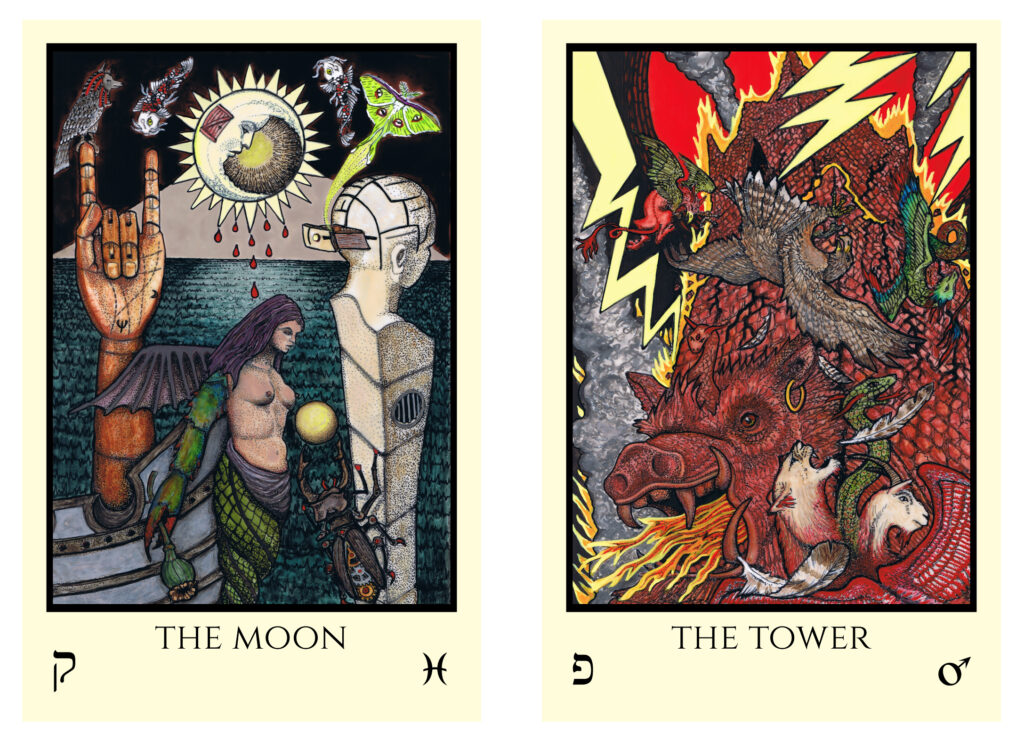
This article is freely offered for your personal use, but please don’t copy it for commercial use. If you would like a copy formatted to fit inside your Book M, you can download it here. You can also copy and format it yourself, to print one copy for personal use with your Tabula Mundi Tarot deck.
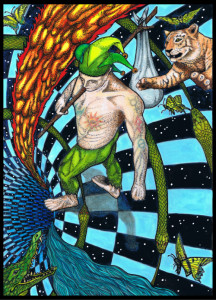
Thank you so much! For four years now, your deck has never left the magnetic board next to my writing desk. I’ve been using it as cosmic calendar and know every card intimately by now (except for Fool, Hanged Man and Judgement, the only cards that don’t appear on the calendar).
Right now, we’re in the last decan of the old astrological year, and the calendar is filled with wild animals 🙂
Nemia
Love that!